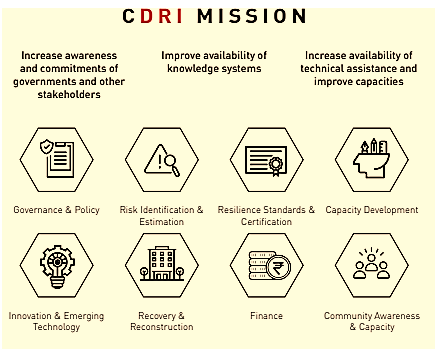Categorization of CDRI
Context
-
Recently, the Union Cabinet chaired by the Prime Minister has approved the categorization of the Coalition for Disaster Resilient Infrastructure (CDRI) as an ‘International Organization’ and signing of the Headquarters Agreement (HQA) with CDRI for granting it the exemptions, immunities and privileges as contemplated under the United Nations (Privileges & Immunities) Act, 1947.
About Categorization of CDRI
- Categorization of CDRI as an ‘International Organisation’ and signing of HQA with CDRI for grant of exemptions, immunities and privileges as contemplated under Section-3 of the United Nations (Privileges & Immunities) Act, 1947 will provide it an independent and international legal persona so that it can efficiently and effectively carry out its functions internationally. This will help the CDRI in:
-
- Deputing experts to other countries, that are particularly vulnerable to disaster risk and / or require support for post disaster recovery and also bringing in experts from member countries to India, for similar purposes;
- Deploying funds globally and receive contributions from member countries, for CDRI activities;
- Making available technical expertise to assist countries to develop resilient infrastructure in accordance with their disaster and climate risks and resources;
- Imparting assistance to countries in adopting appropriate risk governance arrangements and strategies for resilient infrastructure;
- Rendering all possible support to member countries in upgrading their systems to ensure disaster and climate resilience of existing and future infrastructure, while aligning with the Sustainable Development Goals (SDGs), the Paris Climate Agreement and the Sendai Framework for Disaster Risk Reduction;
- Leveraging international engagement to foster disaster resilient infrastructure at home; and,
- Providing Indian scientific and technical institution as well as infrastructure developers an opportunity to interact with global experts. This will help build our own capacities and mechanisms — both in public and private sectors — to support disaster resilient infrastructure development.
- Since its launch, thirty-one (31) Countries, six (06) International Organizations and two (02) private sector organizations have joined as members of CDRI. CDRI has been expanding its membership consistently by attracting a wide variety of economically advanced countries, developing countries, and countries that are most vulnerable to climate change and disasters.

- Over a period of time, a network of organizations / stakeholders will be developed to advance disaster resilient infrastructure not only in India but other partner countries as well.
Back to Basics
About Coalition for Disaster Resilient Infrastructure
- On 28th August, 2019, the Cabinet had approved the setting up of CDRI with its Secretariat in New Delhi.
- The support from Government of India serves as a corpus for CDRI to fund technical assistance and research projects on an ongoing basis, setting up the Secretariat office and covering recurring expenditures over a period of 5 years from 2019-20 to 2023-24.
- The CDRI was launched by the Hon’ble Prime Minister of India during the United Nations Climate Action Summit on the 23rd September, 2019, at New York.
- The CDRI is the second major coalition launched by India outside of the UN, the first being the International Solar Alliance. and is a demonstration of India’s leadership role in climate change and disaster resilience matters, globally.
- CDRI is a global partnership of National Governments, UN agencies and programmes, multilateral development banks and financing mechanisms, the private sector, academic and knowledge institutions that aims to promote the resilience of infrastructure systems to climate and disaster risks, thereby ensuring sustainable development.
Sendai Framework for Disaster Risk Reduction
- The Sendai Framework for Disaster Risk Reduction (2015–2030) is an international document that was adopted by the United Nations (UN) member states between 14 and 18 March 2015 at the World Conference on Disaster Risk Reduction held in Sendai, Japan, and endorsed by the UN General Assembly in June 2015.
- It is the successor agreement to the Hyogo Framework for Action (2005–2015), which had been the most encompassing international accord to date on disaster risk reduction.
About Infrastructure for Resilient Island States (IRIS)
- Launch of IRIS on 2 November 2021 at COP26, Glasgow, UK
- IRIS witnesses high-level political representation from The United Kingdom, India, Australia, Fiji, Jamaica and Mauritius
- IRIS, a dedicated initiative, has been co-created by the Coalition for Disaster Resilient Infrastructure (CDRI) with support from Member Countries and organizations and Small Island Developing States (SIDS) representatives.
- IRIS aims to support SIDS in achieving sustainable development through a systematic approach to resilient, sustainable, and inclusive infrastructure.
- The goal of IRIS will directly contribute to the SAMOA Pathway (Small Island Developing States Accelerated Modalities of Action), and target to deliver three outcomes with progress monitored against these outcomes through the lifecycle of IRIS.
Reference:
https://pib.gov.in/PressReleasePage.aspx?PRID=1837893
Visit Abhiyan PEDIA (One of the Most Followed / Recommended) for UPSC Revisions: Click Here
IAS Abhiyan is now on Telegram: Click on the Below link to Join our Channels to stay Updated
IAS Abhiyan Official: Click Here to Join
For UPSC Mains Value Edition (Facts, Quotes, Best Practices, Case Studies): Click Here to Join
